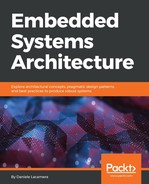Real-time systems have improved their accuracy thanks to the rapid evolution of modern embedded systems, and in particular from the research on interrupt controllers. Assigning different priorities to interrupt lines guarantees a lower interrupt latency for higher-priority interrupt sources, and makes the system react faster to prioritized events. Interrupts may, however, occur at any time while the system is running, including during the execution of another interrupt service routine. In this case, the interrupt controller provides a way to chain the interrupt handlers, and the order of execution depends on the priority levels assigned to the interrupt source.
One of the reasons for the popularity of the Cortex-M family of microprocessors among real-time and low-power embedded applications is perhaps the design of its programmable real-time controller, namely the Nested Vector Interrupt Controller, or NVIC for short. The NVIC supports up to 240 interrupt sources, which can be grouped into up to 256 priority levels, depending on the bits reserved to store the priority in the microprocessor logic. These characteristics make it very flexible, as the priorities can also be changed while the system is running, maximizing the freedom of choice for the programmer. As we already know, the NVIC is connected to the vector table located at the beginning of the code region. Whenever an interrupt occurs, the current state of the executing application is pushed into the stack automatically by the processor, and the service routine associated to the interrupt line is executed.
Systems that do not have an interrupt-priority mechanism implement back-to-back interrupt handling. In these cases, chaining interrupts implies that the context is restored at the end of the execution of the first service routine in line, and then saved again while entering the following one. The NVIC implements a tail-chaining mechanism to execute nested interrupts. If one or more interrupts occur while another service routine is executing, the pull operation normally occurring at the end of the interrupt to restore the context from the stack will be canceled, and the controller will instead fetch the location of the second handler in the interrupt vector and ensure it is executed immediately after the first. Because of the increased pace of the stack save and restore operations being implemented in hardware, the interrupt latency results significantly reduced in all those cases where interrupts are chained. Thanks to its implementation, NVIC allows us to change parameters while the system is running, and is able to reshuffle the order of execution of the interrupt service routines associated to the pending signals, according to the priority levels. Moreover, the same interrupt is not allowed to run twice in the same chain of handlers, which may be caused by altering the priorities in the other handlers. This is intrinsically enforced by the NVIC logic, which ensures that no loops are possible in the chain.
